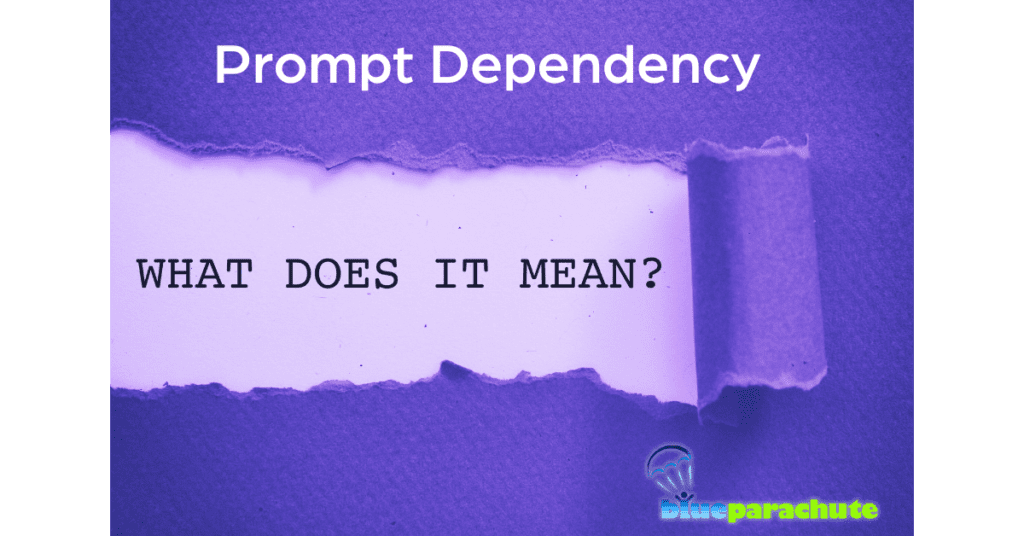Prompt Dependency: The Good, The Bad, & What You Should Know
Prompt dependency is a concept that plays a significant role in various fields, including Applied Behavior Analysis (ABA). In this blog, we’ll delve into the world of prompt dependency, exploring what it is, its positive and negative aspects, and why understanding it is crucial. Whether you’re a parent, a teacher, or a member of the community and you are interested in autism and ABA, this knowledge can help you make informed decisions and implement effective strategies.
What Is Prompt Dependency?
Prompt dependency refers to the reliance on prompts or cues to complete a task or behavior. These prompts can be verbal, visual, physical, or environmental, and they’re often used in ABA and other therapeutic settings to teach new skills or shape existing behaviors.
Prompt Dependence Means Progress
In the realm of ABA therapy, prompt dependency is not inherently negative. In fact, it’s a fundamental part of the learning process, especially for individuals on the autism spectrum. We understand that prompts provide essential guidance, and work toward reducing frustration and increasing the likelihood of a correct response.
Prompt Dependency in Autism
For children with autism, prompt dependency plays a crucial role in skill acquisition. It helps bridge the gap between not knowing how to perform a task and doing it independently. This is one reason this stage of learning can be incredibly beneficial for children on the spectrum, as they often require more explicit teaching methods.
Is Prompt Dependency a Behavior?
Prompt dependency isn’t a behavior in itself. However, it’s closely related to behaviors, specifically those related to learning and skill acquisition. It’s helpful to know the distinction between prompt dependency and behaviors. This can be essential for effective ABA therapy.
The Cycle of Prompt Dependence
Understanding the cycle of prompt dependence is essential. If you are wondering, “What are some examples of prompts?” here is how it typically unfolds:
Prompting
Initially, prompts are heavily used to teach a new skill.
Fading
As the individual progresses, prompts are gradually faded or reduced.
Independence
The ultimate goal is for the individual to perform the task independently.
Maintenance
Once independence is achieved, practicing and maintaining the skill to prevent regression is crucial.
Why Is Prompting Beneficial?
Prompts are invaluable tools in teaching individuals with autism. They offer a structured, supportive way to help learners grasp new skills and behaviors. It’s crucial to recognize their benefits while being mindful of the potential drawbacks.
Several benefits of prompts include:
- Increased success: Prompts boost the chances of a correct response, making learning more successful.
- Reduced frustration: By providing clear cues, prompts can reduce frustration, making the learning process more enjoyable.
- Skill development: Prompts can help individuals with autism acquire new skills that might have been challenging otherwise.
The Dangers of Prompt Dependency
While prompts are beneficial in the learning process, there are potential pitfalls associated with overreliance on them. Some of the drawbacks include:
Limited Independence
If prompts aren’t faded, the individual may become reliant on them, hindering their independence.
Generalization Issues
Prompt-dependent individuals may struggle to apply their skills in different settings or situations.
Frustration With Fading
When prompts are reduced or removed, it can lead to frustration and a reluctance to perform tasks independently.
Avoiding Prompt Dependency
Completely avoiding prompt dependency can be difficult. Prompts can be an invaluable tool when you are teaching a child. However, to prevent prompt dependency from becoming a hindrance, ABA therapists and educators focus on prompt fading. This process involves systematically reducing and eliminating prompts over time. Fading should be carefully planned to ensure a smooth transition toward independence.
Why Is It Important to Fade Prompts?
Fading prompts and decreasing prompt dependency is critical because it leads to greater independence. Any therapy or teaching method aims to equip individuals with the skills and knowledge they need to thrive in various environments and situations. Prompt fading paves the way for true independence.
Be Prompted to Contact Blue Parachute for Helpful Video Resources
Prompt dependency is a fundamental concept in autism and ABA therapy, and it can be a valuable tool for teaching new skills and behaviors. Even so, it’s essential to understand both its positive and negative aspects. Through proper implementation and prompt fading, individuals with autism can progress toward greater independence. This goal remains central in the journey toward effective education and therapy.
If you’re seeking additional resources and support for individuals with autism, videos available from Blue Parachute were all created by Licensed and Certified Behavior Therapists. Our evidence-based content can assist in teaching essential skills and promoting independence. We encourage you to explore our website or use our online form and contact us today. Learn more about our video catalog and subscription pricing. We’ll even let you try it for free for 24 hours.
Related Readings:
Sources:
- AppliedBehaviorAnalysisEdu.org – What Is Prompting, and How Is it Used in ABA Therapy?
- National Institute of Health (NIH) – A Decision-Making Tool for Evaluating and Selecting Prompting Strategies


